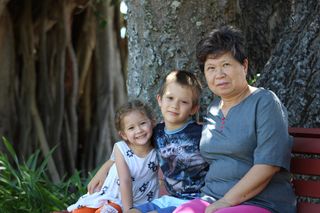Relationships
Types of Polyaffective Relationships: Nonsexual Intimacy
Flexible relationships provide support for adults and children.
Posted August 9, 2018 Reviewed by Ekua Hagan
When I began studying polyamorous relationships in 1996, I learned many new words that members of poly communities in the U.S. had created to express things that the current English language could not articulate. Those polyamorous folks taught me words like compersion (the feeling of glee they get when they see their beloved falling in love with someone else) and metamour (a partner’s partner).
Inspired by their linguistic creativity, I followed suit and created the word polyaffective to describe the nonsexual relationships among people who are related through a polyamorous relationship and thus members of a polycule. Like an expanded version of a molecule, a polycule is a web of interconnected relationships that forms around a polyamorous relationship. Generally, a few members of the polycule have sexual relationships with each other and many do not.
My 20+-year study of polyamorous families with children indicates that it is these polyaffective relationships that are the glue that holds polyamorous families together over time. These flexible and important relationships take a range of forms, and this blog explains how these relationships form among adults, children, and extended family members.
Adults
Polyaffective relationships among adult members of a polycule usually take two primary forms, either between metamours or former lovers.
Metamours
Metamours are partner’s partners who do not generally have sexual relationships with each other. Sometimes people prefer not to meet or know each other's partners at all, a kind of social distance that fits better with other forms of consensual nonmonogamy like monogamish, swinging, open, or relationship anarchy. For people interested in polyamorous relationships, developing emotional relationships and interacting with each other's partners is one of the main ideas.
My research indicates that metamours blend aspects of three primary forms of polyaffective relationship. Chosen siblings create a fraternal relationship based on mutual support tolerance/enjoyment of each other's company and often involving shared interests, congenial mutual ribbing, and occasionally friendly(ish) competition. They pretty much never have sex with their chosen sibs, because they generally do not have that vibe with each other.
Spice, the plural of spouse, is easier to use than brother-husband or co-wife. Adults who develop co-spousal relationships with their spice tend to have a more supportive, less competitive vibe, and often seek out each other's company independent of their shared lover or specific occasions related to shared interests. Spice are emotionally more connected with each other and are generally not lovers. Sometimes they will share eroticism through their mutual lover as a threesome, but they do not often/ever have solo sex with each other. They may also have sexual or romantic relationships outside of the polycule.
When metamours intensely dislike each other they can become enemies. This version could be more likely termed polydisaffective because it both creates animosity between the rivals while injecting tension and dysfunction into the polycule as a whole.
Former Lovers
Polyaffectivity can be expressed between two or more people who used to be in a polyamorous relationship and are no longer lovers. Frequently this happens for folks in long-term relationships who have lost their erotic connection or have incompatible sexual needs/styles but still love each other and want to stay connected as a family. In some cases, they share children and focus on a companionable co-parental relationship while conducting their romantic/sexual relationships independently of their co-parental relationship with their former lover. In other cases, they have been chosen or legally married family for so long and developed such deep connections that the familial relationship far outweighs the previous sexual link. Put another way, simply ending sexual activity was not enough to dismiss the relationship, which is much bigger than a sexual connection.
For another category of people separated by circumstance, distance, and/or a stretch of time in a monogamous/sexually exclusive relationship with someone else, a polyaffective relationship might interrupt a polyamorous relationship with a period of non-sexual connection and then later return to a sexual relationship.
Children
Children of polyamorous families frequently establish polyaffective relationships with chosen family members like aunts/uncles/auntcles and chosen siblings, and far less frequently parents.
Parents
Children in my study always know who their biological parents are and generally identify them as the primary parents. Rarely do these kids see their parents’ partners as parents themselves. In another post, I explained the three requirements for children to consider a parent’s partner to be a full-fledged parent themselves: 1) meet the child when young, 2) stay connected for many years and 3) co-habitate. Most partners do not meet those qualifications and thus fall into a more amorphous chosen family category like an auntcle (a gender-neutral term for aunt or uncle), cousin, or friend of the family.
Aunt/Uncles/Auntcles
In most cases, the children in my study report that they view their parent’s long-term partners as trusted adults who can provide emotional support and practical assistance, but generally do not wield much authority. These adults are not biologically related to the children but create a social bond that is often expressed in play and treats for small children, rides and cash for tweens, and practical and emotional support for teens and young adults. Both adults and children who have participated in my study have told me that they find the not-quite-parent role that these supportive relationships to be fulfilling (especially for the adults) and useful (especially for the kids).
Chosen Siblings
Children also create independent polyaffective bonds with other kids. In some cases, this happens when they bond with their parent’s partners’ children or choose friend/siblings from the kids they meet at poly events. Other children meet a peer at school or some other social setting and form a strong bond completely independent of polyamory. The important thing here is not the source of the sibling, but that the children from polyamorous families follow their parents’ examples and establish chosen familial connections with other kids and adults.
Extended Family

The extended family members of people in polyamorous relationships sometimes create polyaffective relationships with their family member’s polycule. Chosen grandparents can have polyaffective connections with kids they know through their polyamorous children but with whom they have no biolegal connection. As people interact over many years, members of families of origin can become quite attached to their children’s, siblings, or auntcle’s polyculers.




